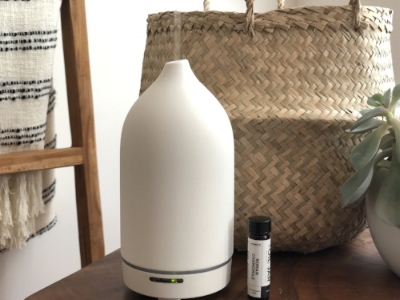Roman Chamomile
Roman Chamomile (Chamaemelum nobile)
Asteracea family
Summer has drawn to a close and we are a month into the new school year. It seems that time goes at warp speed once fall arrives. Early mornings, later evenings, and increasing activities leave my kids (and me) feeling exhausted and cranky. Enter Roman Chamomile, my go to essential oil for tired and cranky kids and adults.
Chamaemelum nobile’s common name is Roman Chamomile, though some refer to it as English chamomile. It is native to western Europe but can be found throughout Europe, North Africa, and Southwest Asia[1]. This beautiful perennial herb has daisy like flowers on hairy stems that creep along the ground and were historically used as ground cover and lawns. Imagine the delicious scent and medicinal value if we all replaced our lawns with this herb?
Roman and German Chamomile are considered the only “true” chamomiles, and while many of their benefits overlap, there are also some differences that will be made clear in a future blog post on German Chamomile.
The essential oil comes from the distillation of it’s daisy-like flowers and tends to range in color from light yellow to light blue. It’s important to remember that it takes a lot of these beautiful flowers to produce the essential oil (Roman chamomile has a low e.o. yield of just 0.8-1.0%), which helps to explain the higher cost. Learn more about why essential oil prices vary here.
This sweet + safe essential oil is one that I use aromatically for my two children, due to it’s significant calming effect on both the mind and the body. It is known as a “children’s oil” due to its gentle nature and kids affinity for its’ sweet apple like scent. When using this for calming + relaxing I find it most helpful in a spritzer, diffuser, and/or in an oil or lotion rub.
Roman Chamomile can also be used with adults for it’s calming effect on mood (it holds a strong mothering energy) and for it’s powerful antispasmodic effect, making it wonderful for cramping or any other muscular tension. Just 2-5 drops of Roman Chamomile in a a Tablespoon of jojoba oil, can help the cramps melt away.
CHEMISTRY:
Looking at the chemistry of an essential oil can tell us about it’s safety, toxicity and in some cases it’s therapeutic possibilities.
Roman Chamomile is very high in the functional group Esters (isobutyl angelate, isobutyl butyrate are examples). Esters tend to make up approximately 80% of the essential oil making it one of the most ester rich essential oils on the market[2]. Some aromatherapists consider isobutyl angelate to be one of the best antispasmodics available[3].
SAFETY
Considered to be non-phototoxic and nonirritant.
RESEARCH
Research on Roman Chamomile essential oil has looked at it’s benefit in the following areas:
Muscle spasm (smooth muscle) [4]
Anxiety [5]
Antimicrobial activity [6]
USE
Historically and in current aromatherapy practice Roman Chamomile is used for:
Mind & Emotions: Calming emotions, good for stress, irritability, + sleepless nights
Skin: soothing the skin when it is red, dry, itchy and/or puffy.
Muscular: cramping + aches and pains
INSIDER TIPS
Remember that you want your supplier to provide the following information about their essential oils…
Common Name: Roman Chamomile
Latin Name: Chamaemelum nobile formerly classified as Anthemis nobilis (Linnaeus)
Country of Origin: Most common areas include United Kingdom, France, USA, Germany, Morocco, Hungary
How was it grown: Organically, ethically, wild-harvested, or conventionally
Extraction: Distillation of flowers
RECIPES
While Roman Chamomile has a variety of uses in aromatherapy, I use it most for it’s profound calming effect on emotions + body. Think cranky, crampy, + sleep deprived when you think of how Roman Chamomile may help you
SOOTHING SPRITZER
I will often make a gentle spritzer to spray on my children at night after bath time + on their pillows and sheets, so that the scent will help to lull them into dream land. This spritzer is calming + soothing to frayed nerves at the end of a long day. (Don’t forget to spray yourself as well)
Supplies:
1 small funnel
2 oz Amber Spray Bottle
2 oz Lavender Hydrosol or Spring Water
14-36 drops Roman Chamomile essential oil
Step 1:
Use the funnel to pour 2 oz lavender hydrosol or spring water into a 2 oz spray bottle
Step 2:
Add 14-36 drops of Roman Chamomile essential oil to the hydrosol. Secure top and shake well before use
Step 3:
Enjoy this soothing spritzer by spraying on the body (avoid face) or in the room up to 3 x per day. Shake before each use to mix oils + avoid spraying on furniture as essential oils can discolor wood and fabrics. Store in a cool dry place and use within 3 months. For extended shelf life store in the refrigerator
CRAMP CALMER
This is a blend that I love specifically for crampy muscles after a long day of running around or during menstruation.
Supplies:
1 or 2 oz amber tincture bottle or glass bottle with lid
1 oz organic jojoba oil (or other carrier oil)
Roman Chamomile essential oil
Marjoram (Origanum majorana) essential oil
Lavender (Lavandula angustifolia) essential oil
Step 1:
Pour 1 oz organic carrier oil into 1 oz amber colored glass bottle
Step 2:
Add 10 drops of Roman Chamomile, 10 drops of Marjoram, and 20 drops of Lavender essential oils to the carrier oil
Step 3:
Secure top and shake well before use. Apply quarter sized amount of mixed oil to sore muscles and crampy areas as needed. Store in a cool dry place and use within 12 months.
CHILL OUT BLEND
My favorite blend of oils for when I am overworked or just wanting to drift off peacefully
Step 1: Mix in a 30 ml empty tincture bottle 5 drops Roman Chamomile, 30 drops Bergamot, and 25 drops Lavender.
Step 2: Add 3-4 drops to your diffuser and run for no more than 30 minutes at a time every 2-3 hours.
[2] Buckle, J. (2015). Clinical aromatherapy: Essential oils in healthcare (3rd ed.). St. Louis, MO: Churchill Livingstone.
[3] Aromatics International. Chemical Families. Retrieved October 1, 2018, from https://www.aromatics.com/pages/learn-chemical-families
[4] Sándor, Z., Mottaghipisheh, J., Veres, K., Hohmann, J., Bencsik, T., Horváth, A., . . . Csupor, D. (2018). Evidence Supports Tradition: The in Vitro Effects of Roman Chamomile on Smooth Muscles. Frontiers in Pharmacology, 9. doi:10.3389/fphar.2018.00323
[5] Wilkinson, S., Aldridge, J., Salmon, I., Cain, E., & Wilson, B. (1999). An evaluation of aromatherapy massage in palliative care. Palliative Medicine, 13(5), 409-417
[6] Bail S et al. Antimicrobial activities of roman chamomile oil from france and its main compounds. Journal of Essential Oil Research. 2009; 21(3): 283-286.






